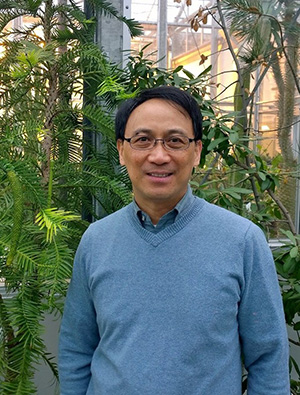Faculty Profile
Danilo Fernando


Associate Professor
Department of Environmental Biology
461 Illick Hall
Research Interests
Research in the Fernando Lab focuses on the reproductive biology of plants including ferns, conifers and woody flowering plants. Current research projects include:
- Gametophyte development and evolution. We are interested in elucidating the mechanisms of gametophyte development and evolution using a combination of approaches including microscopy, tissue culture, genetic transformation, and a range of sequencing and bioinformatic tools related to genomic, transcriptomic and proteomic analyses. We are also interested in the manipulation of the gametophytes for functional genomics, genetic improvement and biotechnology.
- Conservation of plants. Another major focus in our lab is conservation of rare and threatened plants. We are addressing this subject through genetic diversity analysis using PCR- and sequencing- based approaches coupled with in vitro propagation of genetically diverse individuals for use in species and population restoration. We also use in vitro produced individuals to examine growth requirements and/or responses to climate change that are difficult to obtain in the field.
- Mechanism of plant invasiveness. Knowledge on reproductive biology and genetic diversity analysis is also essential in our understanding on how a plant becomes invasive. Thus, our lab is also involved in establishing the basis of invasiveness through analysis of their reproductive biology and genetic make-up (genetic diversity, ploidy levels, population structure, admixture and etc.), and invasion dynamics.
- Reproductive ecology. To better understand the effect of climate change on flowering phenology, we are interested in examining trees that exhibit complex flowering patterns, particularly those that bloom two or three times in a year, or produce trees that are bisexual yet functionally unisexual at specific times of the year. We believe that the critical effect of climate change is not only on the timing of floral initiation per se, but also on the duration of overlap between the receptivity of the two sexes, which determines the occurrence of cross-pollination.
Courses Taught
BTC 132: Biotechnology Orientation Seminar
Course description and objectives: This course is designed for incoming undergraduate students (freshmen and transfers). The students will be introduced to various campus resources, different research disciplines in biotechnology, and faculty members and students in the program. At the end of the course, the students will gain insights useful for course selection and future career choices, appreciate the interconnections amongst the various disciplines, and develop professional skills and attitudes. This course will also serve as a forum to address issues that typically do not fit well into the traditional courses.
Course requirements: Regular attendance to lectures, participation in field trips/tours, and class discussions.
- Syllabus (PDF)
EFB 326: PLANT EVOLUTION, DIVERSIFICATION AND CONSERVATION
Two hours of lecture and one three-hour laboratory. An evolutionary survey of the origin and diversification of plants through geological time. Coverage includes the green algae, bryophytes, lycophytes, pteridophytes, gymnosperms and angiosperms. 3 credits, Spring.
Don't miss the EFB 326 course web page, featuring videos, flashcards, answers to text questions-- it's way cool!:
- Biology of Plants, Eight Edition, Online
- EFB 326 Course Syllabus (PDF)
- Ferns of Onondaga: Beaver Lake (PDF)
EFB 427: PLANT ANATOMY AND DEVELOPMENT
Two hours of lecture and three hours of laboratory. Advances in the fields of genetics and molecular biology are integrated into a dynamic study of plant structure and development. Topics include fertilization, embryogenesis, gene expression and manipulation, and hormonal and environmental regulation of development. 3 credits, Fall.
EFB 797: REPRODUCTIVE BIOLOGY OF TREES
One hour of presentations and discussion. Sexual reproduction in woody species and its importanct to breeding, conservation, and biotechnology are emphasized. 1 credit, Fall.
Publications
Fernando DD, Yun S, Heo N and Kiernan D. 2024. Impact of silvicultural practices on the genetic variations between sugar maple (Acer saccharum March.) stands in the Northern Forest, USA. Forest Ecology and Management 572: 122302.
Heo N, Leopold DJ, Lomolino MV, Yun DS and Fernando DD. 2023. Global and regional drivers of abundance patterns in the hart’s-tongue fern complex (Aspleniaceae). Ann Bot 131: 737–750. PDF
Heo N, Yun S and Fernando DD. 2023. Molecular phylogenetic assessment of three major taxa in the Asplenium scolopendrium complex (Aspleniaceae). Taxon 72: 245-260. PDF
Heo N, Lomolino MV, Watkins JE Jr, Yun S, Weber-Townsend J and Fernando DD. 2022. Evolutionary history of the Asplenium scolopendrium complex (Aspleniaceae), a relictual fern with a northern pan-temperate disjunct distribution. Biol J Linn Soc 137:183-199. PDF
Heo N, Yun S and Fernando DD. 2021. The complete chloroplast genome sequence of Asplenium komarovii Akasawa, a rare fern in South Korea. Mitochondrial DNA Part B 10: 3006-3008.
Salazar AM and Fernando DD. 2019. Predicted functions, subcellular localizations and expression patterns of genes encoding secretory proteins associated with pine pollen germination. Tree Genetics & Genomes 15: 39. PDF
Bouchard JR, Fernando DD, Bailey SW, Weber-Townsend J and Leopold DJ. 2017. Contrasting patterns of genetic variation in central and peripheral populations of Dryopteris fragrans (fragrant wood fern), and implications for colonization dynamics and conservation. International Journal of Plant Sciences 178: 607-617. PDF
Fernando DD, Discenza JJ, Bouchard JR, and Leopold DJ. 2015. Genetic analysis of the threatened American hart's-tongue fern (Asplenium scolopendrium var. americanum [Fernald] Kartesz and Gandhi). Biochemical Systematics and Ecology 62: 25-35. PDF
Quinn CR, Iriyama R, and Fernando DD. 2015. Computational predictions and expression patterns of conserved microRNAs in loblolly pine (Pinus taeda). Tree Genetics & Genomes 11: 806.
Fernando DD. 2014. The pine reproductive process in temperate and tropical regions. New Forests 45: 333-352.
Quinn CR, Iriyama R, and Fernando DD. 2014. Expression of conserved microRNAs in the male gametophyte of loblolly pine (Pinus taeda). Plant Reproduction 27: 69-78.
Seago JL and Fernando DD. 2013. Anatomical aspects of angiosperm root evolution. Annals of Botany 112 (2): 1-16.
Fernando DD, Quinn CR, Brenner E, and Owens JN. 2010. Male gametophyte development and evolution in gymnosperms. Intl J Plant Developmental Biology 4 (Special Issue 1): 47-63. PDF
Fernando DD, Zhang S. 2008. Characterization and heterologous expression of SLF, a functional homolog of the floral regulator LEAFY/FLORICAULA from Salix discolor. International Journal of Plant Developmental Biology 2: 92-99. PDF
Wang BY, Su JR, Fernando DD. 2008. Development of the male reproductive structures in Taxus yunnanensis. Plant Systematics and Evolution 276: 51-58. PDF
Owens JN and Fernando DD. 2007. Pollination and seed production in western white pine. Canadian Journal of Forest Research 37: 260-275.
Fernando DD, Richards JL and Kikkert JR. 2006. In vitro germination and transient GFP expression of American chestnut (Castanea dentata) pollen. Plant Cell Rep 25: 450-456. PDF
Fernando DD. 2005. Characterization of pollen tube development in eastern white pine (Pinus strobus) through proteomic analysis of differentially expressed proteins. Proteomics 5: 4917-4926. PDF
Fernando DD and Zhang S. 2005. Constitutive expression of the SAP1 gene from willow (Salix discolor) causes early flowering in Arabidopsis thaliana. Development, Genes and Evolution 14: 1-10. PDF
Fernando DD, Lazzaro MD and Owens JN. 2005. Growth and development of conifer pollen tubes. Sexual Plant Reproduction 18: 149-162. PDF
Fernando DD, Long SM and Sniezko RA. 2005. Sexual reproduction and crossing barriers in white pines: the case between Pinus lambertiana (sugar pine) and P. monticola (western white pine). Tree Genetics and Genomes 1: 143-150. PDF
Zhang S and Fernando DD. 2005. Structural, histochemical and protein analysis of male reproductive development in willow. Sexual Plant Reproduction 18: 37-41. PDF
Fernando DD and Owens JN. 2004. Development of an in vitro technology to confer white pine blister rust resistance. In Sniezko, R.A. et al. eds. 2004. Breeding and genetic resources of five-needle pines: growth, adaptability and pest resistance; 2001 July 23-27; Medford, OR, USA. IUFRO Working Party 2.02.15. Proceedings RMRS-P-32. Fort Collins, CO: US Department of Agriculture, Forest Service, Rocky Mountain Research Station. Pp. 163-168.
Mueller JK, Heckathorn SA and Fernando DD. 2003. Identification of a chloroplast dehydrin in leaves of mature plants. International Journal of Plant Sciences 164: 535-542.
Owens JN, Takaso T and Fernando DD. 2003. Conifer reproduction: diversity in an ancient group. Acta Horticulturae 615: 115-120.
Fernando DD, Owens JN, Yu X, and Ekramoddoullah AKM. 2001. RNA and protein synthesis during in vitro pollen germination and tube elongation in Pinus monticola and other conifers. Sexual Plant Reproduction 13: 259-264.
Fernando DD, Owens JN and Misra S. 2000. Transient gene expression in pine pollen tubes following particle bombardment. Plant Cell Reports 19: 224-228.
Fernando DD, Owens JN and von Aderkas P. 1998. In vitro fertilization from co-cultured pollen tubes and female gametophytes of Douglas fir (Pseudotsuga menziesii). Theoretical and Applied Genetics 96: 1057-1063.
Fernando DD, Owens JN, von Aderkas P and Takaso T. 1997. In vitro pollen tube growth and penetration of female gametophyte in Douglas fir (Pseudotsuga menziesii). Sexual Plant Reproduction 10: 209-216.
Fernando DD and Cass DD. 1997. Developmental assessment of sexual reproduction in Butomus umbellatus (Butomaceae): male reproductive component. Annals of Botany 80: 449-456.
Fernando DD and Cass DD. 1997. Developmental assessment of sexual reproduction in Butomus umbellatus (Butomaceae): female reproductive component. Annals of Botany 80: 457-467.
Fernando DD and Cass DD. 1996. Genotypic differentiation in Butomus umbellatus (Butomaceae) using isozymes and random amplified polymorphic DNAs. Canadian Journal of Botany 74: 647-652.
Fernando DD and Cass DD. 1996. Development and structure of ovule, embryo sac, embryo, and endosperm in Butomus umbellatus (Butomaceae). International Journal of Plant Sciences 157: 269-279.
Fernando DD and Cass DD. 1994. Plasmodial tapetum and pollen wall development in Butomus umbellatus (Butomaceae). American Journal of Botany 81: 1592-1600.
Current Graduate Advisees
 Margaret Carroll
Margaret Carroll
mrcarrol@syr.edu
- Degree Sought: MS
- Graduate Advisor(s): Fernando
- Area of Study: Environmental & Forest Biology
 Adam Doniger
Adam Doniger
adoniger@syr.edu
- Degree Sought: MS
- Graduate Advisor(s): Fernando
- Area of Study: EFB Plant Science & Biotechnology
Graduate Research Topic
Genetic diversity of beach grass (Ammophila breviligulata) around Lake Ontario.
Favorite Quote
"The commonest way in which we deceive either ourselves or others about understanding is by assuming something as familiar, and accepting it on that account; with all its pros and cons, such knowing never gets anywhere, and it knows not why." - G.W.F. Hegel